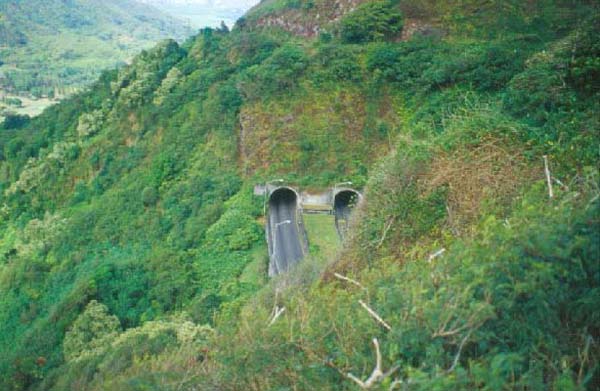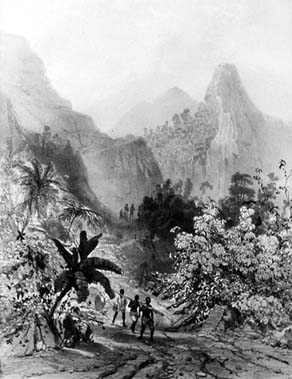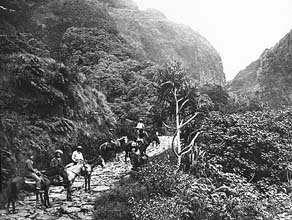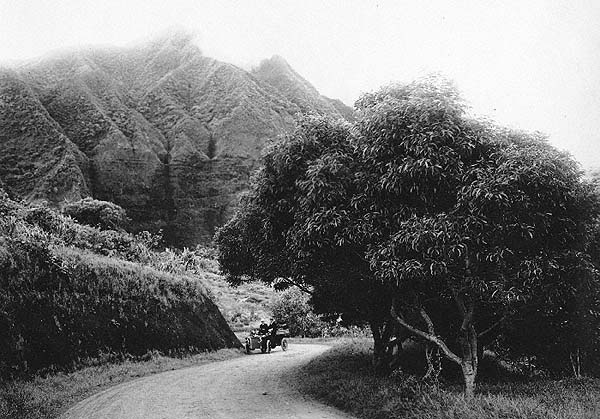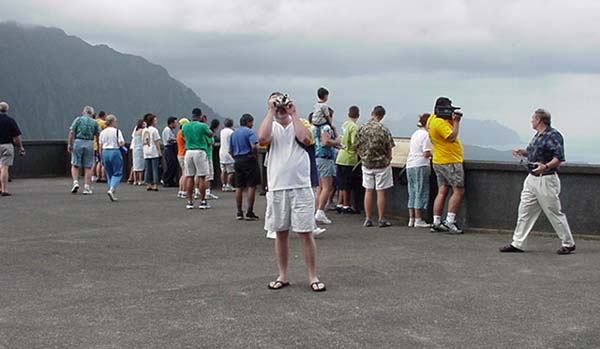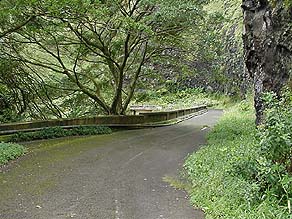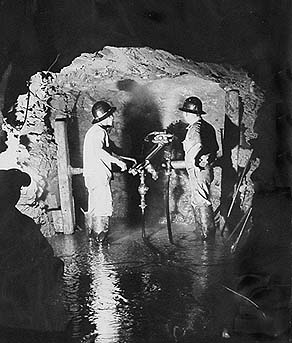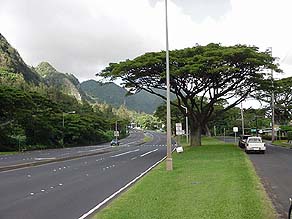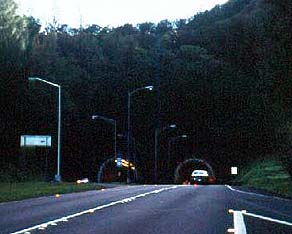 |
 |
 |
|||||||||||||||||||||
|
|
|
|
|
|
|
|
|
||||||||||||||||
|
|
|||||||||||||||||||||||
| |
|
|
|
|
"One day, we learned that there was going to be a highway," Kalani recalls. "And you learned that, but you didn’t really understand until you saw the construction of it. And then there was highway and the tunnel." Nu‘uanu has for centuries been an important transportation route across the mountains, between the Kona and the Ko‘olaupoko districts. In the Stories chapter we learned of various guardian deities who watched over travelers risking the precarious Pali trail. Early Western writers often remarked on this trail and the adventure of descending it. Horses, brought in after Western contact, became the major mode of transportation on this ancient trail. And even by the turn of the century, the route up through Nu‘uanu was a bit of an adventure.
|
||
|
|
||
|
Improvements to the road had been undertaken since the beginning of the 19th century. According to Kamakau, a chief named Keanini was "the first to clear and widen the road and let in the light of the sun. He improved the road in order to draw lumber for building the Kawaiaha‘o church. The logs were cut in Ko‘olauloa, brought by canoe to Kane‘ohe, and hauled over the Pali." Boki, a high chief and governor of O‘ahu during the time of Kamehameha II and Ka‘ahumanu, undertook additional efforts, but encountered some obstacles. Near Kaheiki there was a great rock in his way, but when he went to remove it, a man came up and said,
|
|
|
"Trail up the windward side of the Pali, Honolulu Hawaii" ca. 1890. Photographer: Elias Shura.
|
Similarly, while working on the road up at Luakaha, Boki found a long, pointed rock in his way and went to remove it. A divining kahuna named Lu‘au, who was skilled in pointing out locations, came forward and said to him,
Boki instantly ordered his men to remove the rock, but it extended into the soil so far that after extensive digging, they gave up.
|
|
|
|
|
|
|
Pali road, no lookout,
1883 |
Pali lookout under construction,
|
Pali lookout,
1920s |
Pali lookout,
1930s |
Pali lookout,
1940s |
|
|
||
|
|
|
The highway also points out an environmental impact that has changed the nature of the landscape. Where the old Pali Highway wound its way up the valley and around and down the Pali like the original trail, the new highway involved punching holes through the mountain and installing tunnels. Stephen reports, "When I was growing up, living in Kane‘ohe, this was the route to school up the old Pali Road. And back then, we would entertain ourselves on the long drive, on a rainy day, by looking over the Ko‘olau mountains. You know how kids have these little road games on long trips, like counting out-of-state license plates? We used to count waterfalls to entertain us. I remember those, and I’ve asked old timers 'Do you remember the waterfalls?' And it’s always 'Do you remember the waterfalls…' because they are basically gone. Even on a rainy day, they’re not prominent like I remember they were."
|
|
|
|
Why? The answer has to do with dike-impounded water -- water that is trapped in the vertical rock structure inside the mountains. These "high-level aquifers" are like tubes of water that fill up, until the water pours out the top, making waterfalls on the high mountaintops. "When they realized that the mountains were full of water, from that first main tunnel, they started boring more tunnels to tap more water," Stephen continues. "This is all in the 20’s, and by that time most of the ground water aquifers were being tapped out with artesian wells. So a lot of the water development industry formed. And they began all over the island, once they had the theory about the high level aquifers. So throughout the island tunnels were being bored into mountains. " "Today you see urbanization everywhere. That draws water from the aquifers which are really in the mountains. And you see golf courses. All of this extensive development and use of the land is really at odds with the the natural function of this ahupua‘a."
|
|
|
|
|
"At the time, you didn’t have too many highways that size," Kalani recalls. "Originally the median strips were very wide lawn areas with big monkeypod trees, and they came over and shaded the highway, which I believe was their purpose. Then in the late '60s and '70s, suddenly they took out the big trees, and narrowed that planted area, and put in the third lane, because it was only two-and-two. "That’s when you really noticed it, because then the traffic was much heavier, and faster. I felt, 'Gee, we’re losing a lot of the valley feel.' Then again, you were relieved that all these cars weren’t stopping. I had been away at the time, so I didn’t notice on a day-to-day basis how Honolulu had grown. When I came back I saw the additional highway lanes, and that the monkeypod had been almost all taken out. That was when I felt the impact of the growth. There’s I think one monkeypod left up here, but they were all through this middle section and down the highway until it narrows at Kapena falls."
|
|
|
|
With the Windward side now linked by highway to Honolulu, "the result is constant traffic. People from Kailua or Kane‘ohe use this as a transit way," Kalani remarks. "And they bring their concerns: We want more lights, we want to go faster, why can’t we have a gas station? And so the community would say, No more lights, or, no, you can’t have a gas station. And we don’t want speeding cars through here. That’s been a concern since the 1990s, because prior to that, I don’t know, people just weren’t in so much of a hurry. Now, if someone is delayed in traffic five minutes, they feel that they have the right to go faster. "Now they want to widen the highway, and add on reverse lanes in the morning, so that the traffic can move faster. There have been proposals to elevate the highway, and then add more lights. I don’t know what it will solve, because as soon as they put in that lane, the cars will fill it, and they’ll still be five minutes slower. The community has been against it, especially the newer residents that have moved here specifically to get out of the city. They’ll come up and say, 'I moved here specifically five years ago to get away from that, now don’t you dare do it!'"
|
|
|
|
|
"Highways aren’t the answer." Kalani concludes. "I don’t know what the purpose is. If they say transportation is to move people, right now highways are moving cars, not people. Highways have a strong impact in this valley, and what comes with it--lights, the cars, the new traffic. Now we have people on both sides of the Pali, and it is necessary to move them. It might mean changing habits, or finding a new mode that’s less destructive than building a highway and reaching no limit with that. You’re still only going to move cars. So how do you want to move people?" More on community attitudes and actions in Nu‘uanu is found in the Onwards chapter.
|
||
|
|
||
| |
| |
|
|
 |
| Nu‘uanu Home | Map Library | Site Map | Hawaiian Islands Home | Pacific Worlds Home |
|
|
|||
| Copyright 2003 Pacific Worlds & Associates • Usage Policy • Webmaster |
|||
